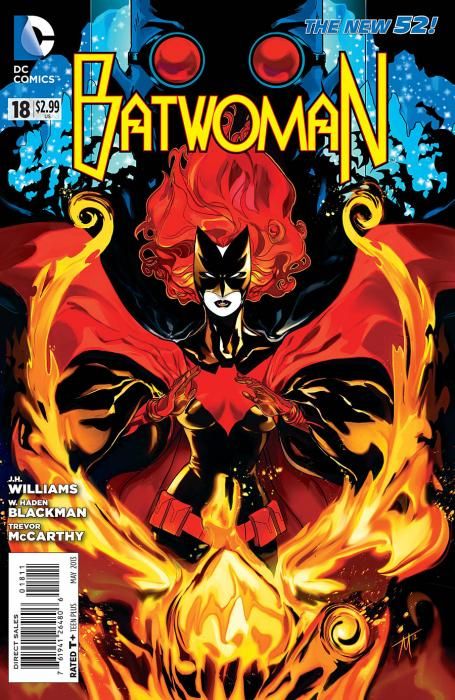What happens after "Marry Me, Mags?" I'd bet I'm not the only reader who has been looking forward to picking up "Batwoman" #18 by J.H. Williams, W. Haden Blackman and Trevor McCarthy to see what happens after Kate Kane's super-dramatic, semi-historic proposal to Detective Maggie Sawyer.
On this front, Williams and Blackman's script for "Batwoman" #18 is weak sauce. If fans of Kate and Mags were expecting more moments worthy of making the rounds on Tumblr, they will be disappointed. "Batwoman" #18 offers only crumbs. After the lush, romantic full-page proposal scene of "Batwoman" #17, Sawyer and Kane don't even share a panel even once in "Batwoman" #18. However, readers will at least find out if Sawyer's answer is a yes or no.
Relationships understandably take a backseat to the crime-fighting for Batwoman herself and for superhero comics in general, and sometimes, the kind of subdued, elliptical flash forward that Williams and Blackman employ here works. In this specific case, though, the lack of more direct follow-up feels like a dodge, cop-out or unnecessary extension of dramatic tension by the writing team after last issue's play for attention.
The Medusa storyline has also wrapped up, and the new crime-fighting storyline is beginning quietly. The psychological and ethical dynamics of the opening scene are gratifyingly messy and complex. Batwoman and Hawkfire each have internally and externally conflicting motivations and they both have something to prove. Bette is finding her way as Hawkfire, and Batwoman is uneasy about her assault on Mr. Freeze. For both Bette and Kate, their impulsive, reckless and rebellious sides are stronger in their mental discomfort, and it is in this unfortunate state that they bump heads with another notable Gotham vigilante.
"Batwoman" as a title and Kate Kane as a character have been defined by layers of secrets both in the past and present. While Kane has taken a step in outing her superhero identity to her lover, her actual superhero activities are shrouded in her being a pawn, against her desire, in larger games, giving her story a noir feel. The characterization in "Batwoman" #18 feels consistent with what the reader knows of Kane while also teasing out new troubles and vulnerabilities.
J.H. Williams is a difficult artistic act to follow, and some fans will inevitably be disappointed that McCarthy's work doesn't have the same painterly appearance and dramatic sweep. McCarthy maintains some visual continuity by adopting or mimicking Williams' unusual circular panels and sprawling page compositions. Judged on its own, McCarthy's work is fine, with smooth storytelling transitions and a striking and confident inking style, and his line has a great variety of texture. His panels are crowded but not cluttered to the point of confusion. Major's coloring reinforces the nighttime mystery and chilly atmosphere of most "Batwoman" #18, and his pale light pinks and yellows on the last page are a great contrast to the ominous feel of events.
The ending cliffhanger of "Batwoman" #18 is a nicely done, and will leave readers curious about the new player the D.E.O. is bringing in to make Batwoman's life even more complicated. "Batwoman" #18 is a soft story arc setup, but future issues will probably remedy its most noteworthy misstep in pacing.

